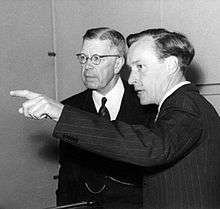Bengt Edlén
Bengt Edlén (2 November 1906, Gusum – 10 February 1993, Lund) was a Swedish professor of physics and astronomer who specialized in spectroscopy. He was the first who identified the unknown coronal spectral lines in the Corona, which was used to calculate the temperature of the corona.

Biography
Bengt Edlén was born on 2 November 1906 in Gusum, Sweden. He graduated from high school in Norrköping in 1926 and entered the University of Uppsala the same year.[1] He was awarded his bachelor's degree after three semester and graduated with a PhD in 1934 with his thesis about the spectra and energy of the elements in the beginning of the periodic system.[2]
He received international fame after finding unidentified spectral lines in the Sun's spectrum which were speculatively believed to originate from a hitherto unidentified chemical element termed coronium. Edlén later showed that those lines are from multiply ionized iron (Fe-XIV). His discovery was not immediately accepted, since the alleged ionization required a temperature of millions of degrees. Later such solar corona temperatures were verified.[3] He also made an important contribution in analyzing spectra of Wolf–Rayet stars.[4][5]
Edlén was professor at Lund University from 1944 to 1973. He was elected a member of the Royal Swedish Academy of Sciences in 1947. He received the Gold Medal of the Royal Astronomical Society 1945 for the solution of the Corona Mystery,[6] the Howard N. Potts Medal in 1946 for researches in the extreme ultraviolet,[7] and the Henry Draper Medal of the National Academy of Sciences[8] in 1968.
References
- Hockey, Thomas (2009). The Biographical Encyclopedia of Astronomers. Springer Publishing. ISBN 978-0-387-31022-0. Retrieved 22 August 2012.
- Forkman, Bengt; Holmin Verdozzi, Kristina, eds. (2016). Fysik i Lund: i tid och rum (in Swedish). Lund: Fysiska institutionen i samarbete med Gidlunds förlag. p. 84. ISBN 9789178449729.
- Litzén, Ulf (2015). Fysik i Lund under 300 år (in Swedish). Lund: Lunds universitetshistoriska sällskap. pp. 126–127. ISBN 9789175453200.
- Beals, C. S. (1933). "Classification and temperatures of Wolf-Rayet stars". The Observatory. 56: 196–197. Bibcode:1933Obs....56..196B.
- Swings, P. (1942). "The Spectra of Wolf-Rayet Stars and Related Objects". Astrophysical Journal. 95: 112–133. Bibcode:1942ApJ....95..112S. doi:10.1086/144379.
- "Winners of the Gold Medal of the Royal Astronomical Society". Royal Astronomical Society. Archived from the original on 25 May 2011. Retrieved 24 February 2011.
- "The Franklin Institute Awards". The Franklin Institute. 3 February 2014. Retrieved 30 April 2017.
- "Henry Draper Medal". National Academy of Sciences. Archived from the original on 26 January 2013. Retrieved 24 February 2011.